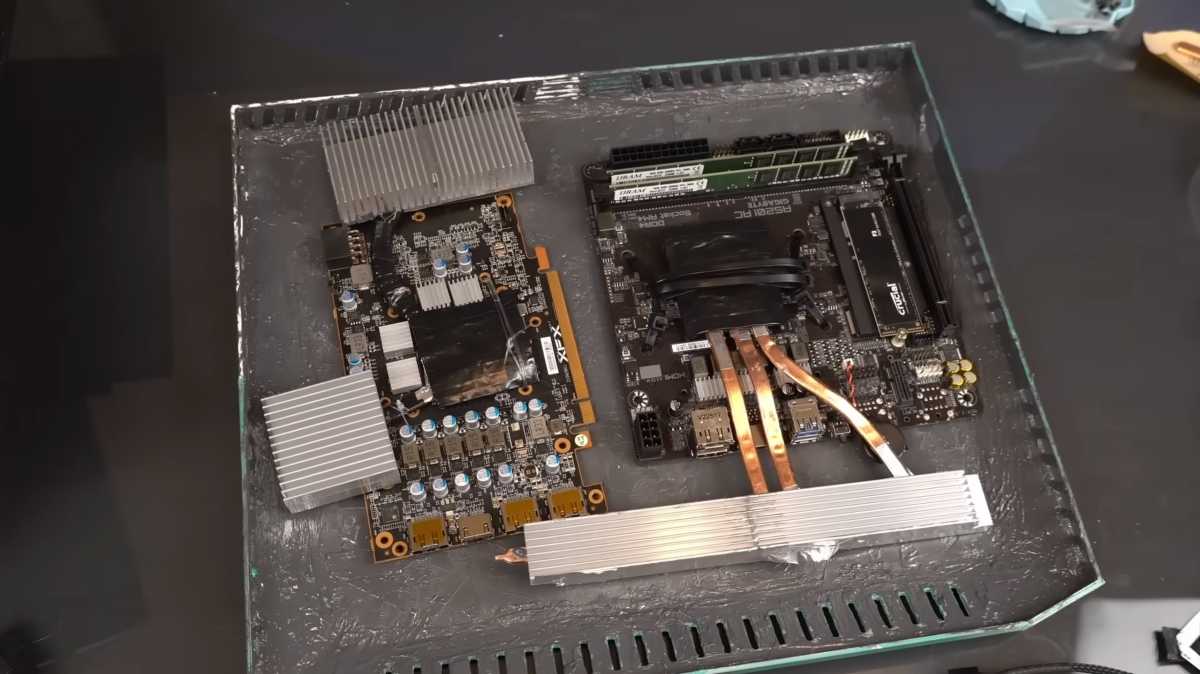This guy crammed desktop gaming parts into a laptop — and it didn’t explode
Don’t let anyone tell you otherwise: gaming laptops are awesome. After decades of being looked down upon by “real” PC gamers, they can now go toe-to-toe with gaming desktops.
But if you want ultimate performance, you still need a full-blown desktop build… unless you’re YouTuber Socket Science. Then you just cram a bunch of desktop parts into a laptop-shaped box, spit and polish with some engineering skills, and call it a day.
Okay, fine, it’s a little more complicated than that. In fact, according to Socket Science’s video (spotted by Hackaday), it took no less than 14 months and “countless curse words” to turn this vision into reality.
The end result looks pretty much like a standard gaming laptop, albeit on the chunky side. But hiding underneath is a desktop motherboard, desktop processor, desktop GPU, desktop RAM… you get the picture.
As the builder explains, laptop gaming parts aren’t as powerful as their desktop counterparts, even when they’re given the same name (as Nvidia does with its RTX mobile GPUs). That’s kind a necessity because of a little something called physics.
Even if you could get the same exact parts from a desktop into a laptop, they’d output too much heat for the limited space of a laptop chassis and require a lot more cooling. The equation has to be balanced out — if you want a portable machine that can run for more than 20 minutes without melting your face, you have to give up some performance.
But you can bend the rules of physics, at least a little bit, and that’s what’s happening here. Socket Science took a mini-ITX A520 motherboard, an AMD Ryzen 5 5600X CPU, an AMD Radeon RX 6600 GPU, some low-profile RAM, and a standard M.2 2280 storage drive. He threw on some off-the-shelf hardware to stand in for laptop components, a thin keyboard and touchpad and a USB-based portable monitor for the screen, and a DC-to-DC power supply.
Then, he had to snip off all the motherboard ports he wouldn’t be using, pull off the cooling hardware on the CPU and GPU, and use a riser cable to get the graphics card laying flat. He custom-designed and 3D-printed the primary body, then built his own cooling setup from scratch using tons of copper contact plates, heat pipes, and heatsinks bought in bulk. He hand-bent the pipes into the shapes he needed.

 Socket Science
Socket Science
 Socket Science
Socket Science
Socket Science
Socket Science
Even with tons of heat movement, you need adequate fan power to get it all out of the box when you’re running parts this beefy. Off-the-shelf electronics fans weren’t going to cut it, so once again Socket Science had to model his own in CAD to be 3D-printed, applying it to the original motor for the AMD cooler in the CPU box. One of the desktop GPU fans — sans cooler and housing — was also salvaged.
With the core components apparently working, the rest of the build was all about getting existing parts out of their original housing and into his custom laptop body. The keyboard, trackpad, and USB-connected screen all fit well enough into the custom 3D-printed chassis. The USB monitor even came with tiny speakers all hooked up and ready to go. He also got a little blingy with some custom copper-painted accents and a logo, just to give it that gaming laptop feel.
The whole thing works, even if it has a bit of an Etsy look to it. Though I have to point out in the face of Socket Science’s overall disdain for gaming laptops, his custom machine doesn’t count as a true “gaming laptop” without a battery.
Want something similar? If you don’t have a mechanical engineering degree and a year and change to build your own, you might want to stick to something like the Framework 16 for a DIY gaming laptop that you can take apart and put back together.
Further reading: The absolute best gaming laptops
